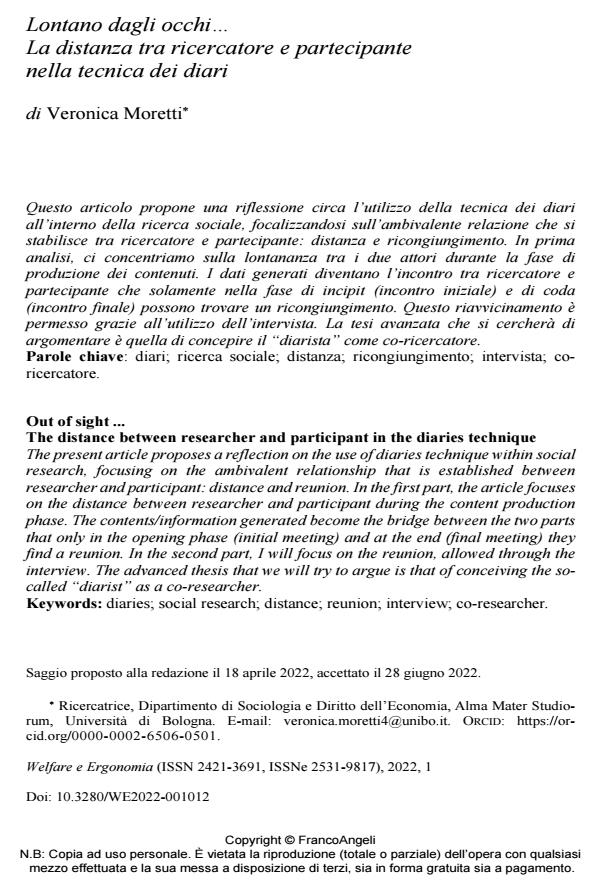Lontano dagli occhi.. La distanza tra ricercatore e partecipante nella tecnica dei diari
Titolo Rivista WELFARE E ERGONOMIA
Autori/Curatori Veronica Moretti
Anno di pubblicazione 2022 Fascicolo 2022/1
Lingua Italiano Numero pagine 11 P. 157-167 Dimensione file 388 KB
DOI 10.3280/WE2022-001012
Il DOI è il codice a barre della proprietà intellettuale: per saperne di più
clicca qui
Qui sotto puoi vedere in anteprima la prima pagina di questo articolo.
Se questo articolo ti interessa, lo puoi acquistare (e scaricare in formato pdf) seguendo le facili indicazioni per acquistare il download credit. Acquista Download Credits per scaricare questo Articolo in formato PDF

FrancoAngeli è membro della Publishers International Linking Association, Inc (PILA)associazione indipendente e non profit per facilitare (attraverso i servizi tecnologici implementati da CrossRef.org) l’accesso degli studiosi ai contenuti digitali nelle pubblicazioni professionali e scientifiche
Questo articolo propone una riflessione circa l’utilizzo della tecnica dei diari all’interno della ricerca sociale, focalizzandosi sull’ambivalente relazione che si stabilisce tra ricercatore e partecipante: distanza e ricongiungimento. In prima analisi, ci concentriamo sulla lontananza tra i due attori durante la fase di pro-duzione dei contenuti. I dati generati diventano l’incontro tra ricercatore e par-tecipante che solamente nella fase di incipit (incontro iniziale) e di coda (incon-tro finale) possono trovare un ricongiungimento. Questo riavvicinamento è per-messo grazie all’utilizzo dell’intervista. La tesi avanzata che si cercherà di argo-mentare è quella di concepire il "diarista" come co-ricercatore.
Parole chiave:diari; ricerca sociale; distanza; ricongiungimento; intervista; co-ricercatore.
- Alaszewski A. (2006). Using Diaries for Social Research. London: Sage
- Bartlett R. and Milligan C. (2015). What is diary method?. London: Bloomsbury Academic.
- Bryman A. (2001). Social Research Methods. Oxford: Oxford University Press.
- Bytheway B. and Johnson J. (2002). Doing diary-based research. In: Jamieson A. and Victor C., Eds., Researching Ageing and Later Life. Buckingham: Open University Press, pp. 156-174.
- Cardano M. (2011). La ricerca qualitativa. Bologna: il Mulino.
- Corti L. (2003). Diaries, self-completion. In: Miller R.L. and Brewer J.D., Eds., The A-Z of Social Research. London: Sage, pp. 69-74.
- Coxon A.P.M. (1996). Between the Sheets: Sexual Diaries and Gay Men’s Sex in the Era of AIDS. London: Cassell.
- Denzin N.K. (1970). The Research Act: A Theoretical Introduction to Sociological Methods. Chicago: Aldine.
- Denzin N. and Lincoln Y. (1994). Handbook of qualitative research. Thousand Oaks, CA: Sage.
- Elliott H. (1997). The Use of Diaries in Sociological Research on Health Experience. Sociological Research Online, 38-48.
- Fetterman D.M. (1998). Ethnography: Step by Step, 2nd edn. Thousand Oaks, CA: Sage.
- Frank A. (2000). The standpoint of storyteller. Qualitative Health Research, 10: 354-365. DOI: 10.1177/104973200129118499
- Harvey L. (2011). Intimate reflections: Private diaries in qualitative research. Qualitative Research, 11(6): 664-682. DOI: 10.1177/1468794111415959
- Hislop J., Arber S., Meadows R. and Venn S. (2005). Narratives of the night: The use of audio diaries in researching sleep. Sociological Research Online, 10(4).
- Kara H. (2015). Creative research methods in the social sciences: A Practical Guide. Bristol: Policy Press.
- Miczo N. (2003). Beyond the “fetishism of words”: Considerations on the use of the interview to gather chronic illness narratives. Qualitative Health Research, 13: 469-490. DOI: 10.1177/1049732302250756
- Milligan C. (2005). Placing narrative correspondence in the geographer’s toolbox: Insights from care research in New Zealand. New Zealand Geographer, 61: 213-224.
- Milligan C. and Bartlett R. (2019). Solicited diary methods. In: Liamputtong P., Ed., Handbook of research methods in health social sciences, pp. 1447-1464. Singapore: Springer.
- Monrouxe L.V. (2009). Solicited audio diaries in longitudinal narrative research: a view from inside. Qualitative research, 9(1): 81-103. DOI: 10.1177/1468794108098032
- Moretti V. and Chakraborty A. (2020). Media Habits and Covid-19. Using Audio-Diaries Technique to Explore “Official” Information Consumption. Fuori Luogo, 7(1): 97-104.
- Moretti V. (2021). Dear (Digital) Diary: Evaluating the Audio Diary Technique as a Research Method. In: Handbook of Research on Advanced Research Methodologies for a Digital Society, Hershey: IGI Global, pp. 375-389.
- Ochs E. and Capps L. (2001). Living Narrative: Creating Lives in Everyday Storytelling. Cambridge MA: Harvard University Press.
- Ohly S., Sonnentag S., Niessen C. and Zapf D. (2010). Diary studies in organizational research. Journal of Personal Psychology, 9(2): 79-93.
- Rauch M. and Ansari S. (2022). Waging War from Remote Cubicles: How Workers Cope with Technologies That Disrupt the Meaning and Morality of Their Work. Organization Science.
- Ricœur P. (1984). Time and Narrative. Chicago: University of Chicago Press.
- Smyth J.M. (1998). Written emotional expression: Effect sizes, outcome types and moderating variables. Journal of Consulting and Clinical Psychology, 66(1): 174-184. DOI: 10.1037/0022-006X.66.1.174PMID:9489272
- Sorokin P.A. and Berger C.Q. (1939). Time-Budgets of Human Behavior. Cambridge, Mass.: Harvard Univ. Press.
- Wiedner R. and Ansari S. (2017). Appreciating emergence and serendipity in qualitative research: Resisting the urge to follow set plans. In: Mir R. and Jain S., The Routledge Companion to Qualitative Research in Organization Studies. New York, NY: Routledge.
- Williamson I., Leeming D., Lyttle S. and Johnson S. (2015). Evaluating the audio diary method in qualitative research. Qualitative Research Journal, 15(1): 1-28 and 20-34.
- Worth N. (2009). Making Use of Audio Diaries in Research with Young People: Examining Narrative, Participation and Audience. Sociological Research Online. 14(4): 77-87.
- Zimmerman D.H. and Wieder D.L. (1977). The diary Diary-Interview Method. Urban Life, 5(4): 479-498. DOI: 10.1177/089124167700500406
- Znaniecki F. (1934). The Method of Sociology. New York: Farrar and Rinehart.
Veronica Moretti, Lontano dagli occhi.. La distanza tra ricercatore e partecipante nella tecnica dei diari in "WELFARE E ERGONOMIA" 1/2022, pp 157-167, DOI: 10.3280/WE2022-001012